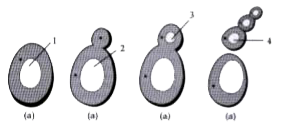Organisms reproducing by asexual reproduction show a few variation.
Step-by-Step Solution
1. Understanding Asexual Reproduction: Asexual reproduction involves a single parent organism that produces offspring. This process does not involve the fusion of gametes (sperm and egg), and the offspring are genetically identical to the parent.
2. Genetic Material Transfer: In asexual reproduction, the parent organism passes on 100% of its genetic material to its offspring. This means that the offspring are clones of the parent, exhibiting very little to no variation.
3. Variations in Asexual Reproduction: Although asexual reproduction typically results in genetically identical offspring, variations can occur due to mutations or environmental factors. These variations are usually minimal compared to the genetic diversity seen in sexual reproduction.
4. Comparison with Sexual Reproduction: In sexual reproduction, two parents contribute genetic material, leading to a mixture of genes. This results in greater genetic diversity and variations among the offspring. However, the question states that organisms reproducing asexually show a few variations, which emphasizes that while they are mostly identical, slight differences can arise.
5. Conclusion: Therefore, while organisms that reproduce asexually are primarily clones of their parent, they can exhibit minimal variations due to mutations or environmental influences. This is in contrast to sexual reproduction, which typically results in a wider range of variations among offspring.
Topper's Solved these Questions
- HEREDITY AND EVOLUTIONBOOK - MBD -HARYANA BOARDCHAPTER - HEREDITY AND EVOLUTIONEXERCISE - Long Answer Type Questions
2 Videos
- CONTROL AND COORDINATIONBOOK - MBD -HARYANA BOARDCHAPTER - CONTROL AND COORDINATIONEXERCISE - EXAMPLE
150 Videos
- HOW DO ORGANISMS REPRODUCE?BOOK - MBD -HARYANA BOARDCHAPTER - HOW DO ORGANISMS REPRODUCE?EXERCISE - EXAMPLE
185 Videos
Similar Questions
Knowledge Check
An organism is reproducing by asexual method of reproduction. The organism splits into two identical daughter cells. This happens when the cellular organism reaches to its maximum size of growth and then the nucleus of the organism elongates and divides into two parts. After that the cytoplasm also divides into two parts along with cell.
Name the process by which the organism reproduceABinary fissionBBuddingCSporulationDNone of theseAn alga which reproduces by the asexual reproduction method called fragmentation is :
ARhizopusBSalmonellaCPlasmodiumDSpirogyraOffspring formed by sexual reproduction exhite more variation than those formed by asexual reproduction because :
Asexual reproduction is a length process.Bgametes material comes from parents of two different genetic compositon .Cgenetic material comes from parents of two different species.Dgreater amount of DNA is involved in sexual reproduction
Which of the processes, sexual reproduction or asexual reproduction, brings about maximum variations in the off springs ?
View SolutionWhich of the processes, sexual reproduction or asexual reproduction, brings about maximum variations in the offsprings?
View Solutionfungi reproduce only asexually.
View SolutionThe organisms formed by asexual reproduction are considered as clones. Why ? State the advantages of sexual reproduction over asexual reproduction.
View SolutionOffspring formed by sexual reproduction exhibit more variation than those formed by asexual reproduction because
View Solution

